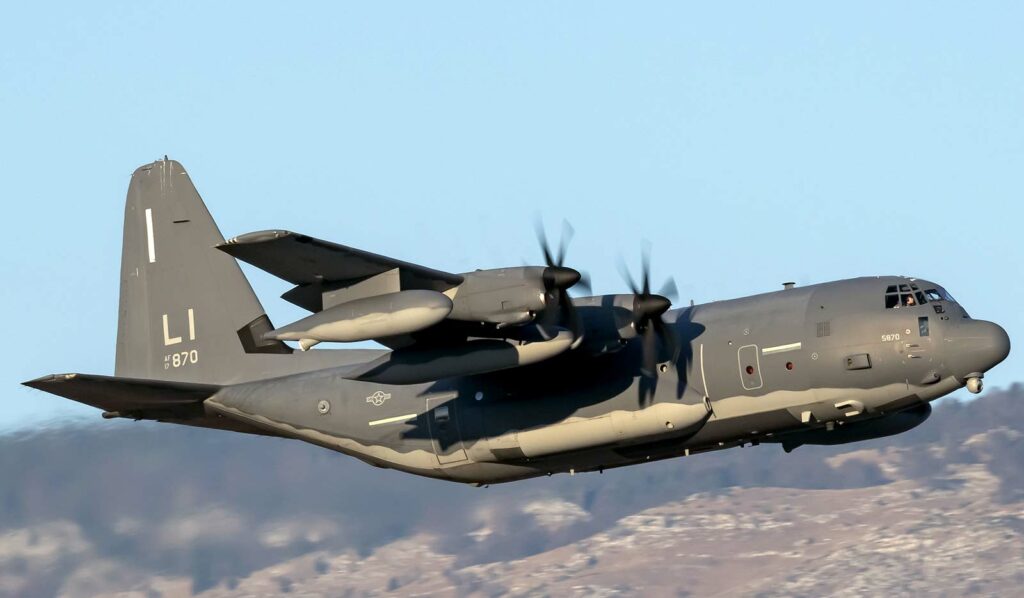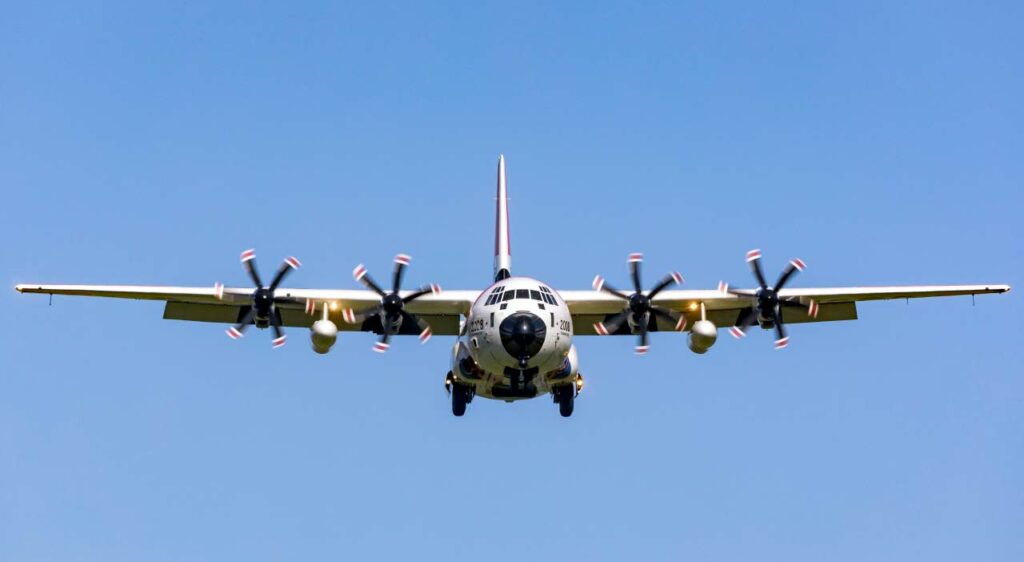The Lockheed HC-130 Hercules is a long-endurance, search and rescue (SAR) and combat search and rescue (CSAR) variant of the C-130 Hercules.
In Brief
The Lockheed HC-130 Hercules is a specialized variant of the versatile C-130 airframe, tailored for search and rescue (SAR) and combat search and rescue (CSAR) missions. Equipped with advanced navigation, electronic, and communication systems, it excels in roles including airborne command and control, air-sea rescue, environmental reconnaissance, and aerial refueling for helicopters. The HC-130 can perform in diverse operational theaters, from Arctic to desert, demonstrating exceptional endurance, range, and versatility. It’s designed for precision insertion/extraction of personnel, disaster response, and is a critical asset in extended-range SAR operations.
The Lockheed HC-130 Hercules is an embodiment of versatility and resilience, primarily serving as the U.S. Air Force’s premier fixed-wing search and rescue aircraft. This variant of the Hercules family is specifically designed to perform combat search and rescue (CSAR) and airborne command and control, particularly under the Air Combat Command, Air Force Special Operations Command, and the Coast Guard.

History of the Development of the Lockheed HC-130 Hercules
The Lockheed HC-130 Hercules has a rich history that mirrors the evolution of aerial search and rescue missions. Post World War II, the U.S. Air Force identified a growing need for a specialized aircraft capable of performing search and rescue (SAR) operations, particularly for long-range missions. The introduction of jet aircraft and the expansion of the U.S. nuclear arsenal necessitated a platform that could provide rapid recovery and aerial refueling capabilities.
The development of the HC-130 began in the 1950s when the Air Force sought an aircraft that could undertake both overland and overwater SAR tasks, leading to the adaptation of the C-130 Hercules airframe. The Lockheed Corporation, recognizing the C-130’s robustness and versatility, initiated modifications to create a variant optimized for search and rescue missions. The first HC-130 configuration, known as the HC-130H, took flight in the early 1960s, tailored with extended-range fuel tanks, advanced navigation systems, and specialized equipment for its SAR role.
The aircraft was specifically engineered to locate downed aircrew and personnel, provide them with supplies, and coordinate rescue operations. Over the decades, the HC-130 has been continuously upgraded to incorporate advanced technology, including improved radar, enhanced navigation systems, and state-of-the-art communication suites to effectively execute its mission in complex and demanding environments.
The HC-130’s design evolution reflects its adaptability to changing mission requirements and technological advancements. It became an invaluable asset during the Vietnam War, where it played a crucial role in combat search and rescue operations, extracting downed pilots from hostile territories. Its capability to refuel helicopters in mid-air revolutionized SAR operations, significantly extending the reach and endurance of rotary-wing assets.
The HC-130 does not have a specific NATO nickname, but it is widely recognized within military circles for its critical role in personnel recovery and aerial refueling tasks. Its continued development and adaptation exemplifies the military’s commitment to enhancing the effectiveness and safety of SAR missions, ensuring that the HC-130 remains a cornerstone of U.S. and allied rescue operations.
Design of the Lockheed HC-130 Hercules
The Lockheed HC-130 Hercules is strategically designed to optimize the efficiency and safety of search and rescue missions. The aircraft’s design incorporates several modifications and enhancements over the standard C-130 Hercules, specifically tailored to its unique operational requirements.
Key design features of the HC-130 include advanced navigation systems, enhanced communication suites, and specialized surveillance equipment, enabling it to locate and assist distressed personnel over vast and inhospitable terrains. The aircraft is equipped with high-performance radar systems capable of detecting and tracking ground and maritime targets, crucial for pinpointing the location of individuals in distress.
The HC-130’s airframe is adapted to house additional fuel tanks, extending its operational range and endurance significantly. This capability is vital for conducting extended search and rescue missions, particularly in remote or challenging environments. The aircraft can also perform aerial refueling, a critical function that extends the operational range of rescue helicopters and other compatible aircraft.
Equipped with sophisticated electronic and infrared sensors, the HC-130 can conduct missions in low-light, night-time, or adverse weather conditions, enhancing its operational flexibility. The aircraft’s robust communication systems facilitate real-time coordination with ground, air, and maritime assets, ensuring efficient execution of complex SAR operations.
In terms of performance, the HC-130 is powered by four turboprop engines, providing the thrust needed for long-duration flights and the ability to operate from short or unprepared airstrips. The aircraft’s versatile design allows for rapid reconfiguration to accommodate a variety of mission-specific equipment, including medical facilities for onboard patient care, making it an indispensable asset for a wide range of humanitarian and military operations.
Despite its numerous advantages, the HC-130’s specialized design comes with certain drawbacks. The complexity and sophistication of its systems require extensive training for crew members, and the aircraft’s maintenance demands are significant, necessitating a high level of logistical support. However, the HC-130’s unparalleled capabilities in extended-range SAR and aerial refueling missions far outweigh these challenges, underscoring its vital role in air rescue and recovery operations.
Performance of the Lockheed HC-130 Hercules
The Lockheed HC-130 Hercules is renowned for its outstanding performance in search and rescue operations, attributed to its robust design and powerful engine configuration. Equipped with four Allison T56-A-15 turboprop engines, each producing 4,910 horsepower, the HC-130 can achieve a maximum speed of over 320 knots (approximately 368 mph or 592 km/h) and boasts an impressive range exceeding 4,000 nautical miles (about 4,600 miles or 7,400 kilometers) without refueling.
This extended range is crucial for the aircraft’s primary mission of long-duration search and rescue operations, allowing it to cover vast distances over land or water. The HC-130’s operational ceiling exceeds 33,000 feet (10,000 meters), enabling it to perform high-altitude missions and evade lower-altitude threats effectively.
One of the HC-130’s hallmark features is its air-to-air refueling capability, specifically for helicopters, which extends the endurance of rescue operations and allows helicopters to operate far beyond their standard operational ranges. This feature is particularly beneficial in vast or inaccessible areas where fixed-wing aircraft can reach survivors or distressed personnel long before rotary-wing assets.
When compared to similar aircraft in its class, the HC-130 stands out for its unique combination of long endurance, extensive range, and versatile mission capabilities. While other aircraft might excel in speed or payload capacity, the HC-130’s design is optimized for the specific requirements of search and rescue missions, making it an invaluable asset in scenarios where time, endurance, and adaptability are critical.
The aircraft’s performance is not just about its technical specifications; it also encompasses its ability to operate in diverse environmental conditions, from arctic cold to desert heat, showcasing its operational versatility. This adaptability, combined with the aircraft’s robust construction and reliable performance, ensures that the HC-130 remains a key player in both military and humanitarian operations worldwide.
Variants of the Lockheed HC-130 Hercules
The Lockheed HC-130 Hercules family comprises several variants, each tailored to specific operational requirements while maintaining the core capabilities that define this versatile aircraft. The primary variants include:
- HC-130P/N “King”: This variant is equipped with refueling pods for helicopter aerial refueling and a suite of advanced navigation and communication systems. It’s designed for long-range SAR and CSAR missions, providing on-scene command and control and extending the endurance of rescue helicopters.
- HC-130J “Combat King II”: The latest and most advanced variant, featuring improved technology, extended range, and enhanced performance. It includes new propellers, engines, and avionics, offering significant improvements in speed, range, and capability over its predecessors. This model is specifically designed for precision airdrop, airland, and helicopter air-to-air refueling missions.
- HC-130H: An older variant used primarily by the Coast Guard for long-range search and rescue missions, pollution control, and logistics support. Although it shares the Hercules platform, it has been outfitted with specialized equipment for maritime patrol and environmental protection missions.
Each variant of the HC-130 has been developed with specific mission profiles in mind, showcasing a blend of versatility and specialized capability. The differences lie mainly in their avionics, mission systems, and sometimes power plants, tailored to enhance their effectiveness in the roles they are designated to perform.

Military Use and Combat of the Lockheed HC-130 Hercules
The Lockheed HC-130 Hercules has a storied history in military operations, serving as a cornerstone of the U.S. Air Force’s search and rescue (SAR) and combat search and rescue (CSAR) capabilities. Its primary role is to conduct both overland and maritime SAR missions, providing command and control, and facilitating the recovery of personnel in austere and hostile environments.
In combat scenarios, the HC-130’s mission extends to deploying pararescuemen (PJs) and recovery of isolated personnel in enemy territory, often under challenging conditions. Its capability for aerial refueling of helicopters is pivotal, enabling extended-range rescue missions that have saved countless lives in conflict zones.
The HC-130 has been actively involved in numerous conflicts, including the Vietnam War, where it played a critical role in the recovery of downed aircrew members. Its operations have not been limited to wartime missions; it has also been instrumental in countless peacetime rescues, humanitarian relief operations, and disaster response efforts worldwide.
Its armament is typically non-offensive, focusing on defense countermeasures to ensure mission success and crew safety in adversarial environments. The aircraft’s extensive range, endurance, and payload capacity have allowed it to adapt to various roles beyond SAR, including aerial refueling, weather reconnaissance, and maritime patrol.
The HC-130 has faced competition from other SAR aircraft like the P-8 Poseidon or the C-295, but its unique capabilities, especially in extended-range SAR and precision aerial delivery, have ensured its continued relevance. Moreover, its adaptability has led to international sales, with variants used by allied nations for similar SAR and CSAR roles.
Currently, the HC-130 continues to serve with distinction, and ongoing upgrades ensure it remains a vital asset in the U.S. military’s inventory. Future replacements or enhancements are aimed at maintaining the platform’s edge in technology and capability, ensuring that it continues to save lives and perform critical missions in the most demanding conditions.
The Lockheed HC-130 Hercules stands as a testament to the enduring value of the Hercules airframe, specifically tailored to meet the demanding requirements of search and rescue operations. Its design, performance, and versatility have made it an indispensable asset in the SAR and CSAR roles, demonstrating unparalleled capability in personnel recovery, precision deployment, and aerial refueling. As it continues to evolve with advancements in technology, the HC-130 Hercules will remain a cornerstone of humanitarian and combat search and rescue operations, saving lives and executing missions in the most challenging conditions imaginable.
Back to the Spy Planes section.